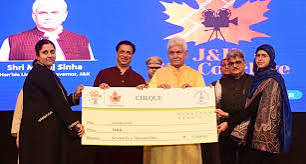In the verdant valleys and towering peaks of Jammu and Kashmir, a new narrative is unfolding—one that transcends its complex past and aspires to cast the region in the limelight of global cinema. The announcement of the Film Policy-2024 by Lieutenant Governor Manoj Sinha at the J&K Film Conclave represents more than a mere administrative maneuver; it is a vision document, a blueprint for reviving and redefining J&K’s cinematic identity on the world stage.
The region of Jammu and Kashmir, historically recognized for its picturesque landscapes and cultural richness, has long been a favorite among filmmakers. The legacy of icons like Raj Kapoor, who immortalized Kashmir’s beauty on screen, speaks volumes about the deep-seated relationship between this land and the film industry. However, this relationship had seen a decline due to various socio-political challenges over the years. The introduction of the new film policy is a significant step towards reclaiming and rejuvenating this legacy.
At the heart of the Film Policy-2024 is the establishment of a Single Window Cell, a critical feature designed to streamline the bureaucratic processes involved in film production. This initiative acknowledges and addresses the cumbersome hurdles that filmmakers often face, which can dampen the creative process. By simplifying procedures for obtaining permissions and facilitating access to necessary resources, the policy ensures that filmmakers can focus solely on their craft—telling compelling stories set against the backdrop of J&K’s stunning natural vistas. This move not only saves time and reduces logistical headaches but also signals a welcoming gesture from the local administration to the global film community.
Moreover, the policy’s emphasis on developing infrastructure to meet international standards cannot be understated. The promise of state-of-the-art facilities and services positions Jammu and Kashmir as a competitive player in the global market for film production. This development is not merely about constructing buildings or setting up studios; it is about creating an environment where technical excellence and artistic expression can flourish in unison. With proper infrastructure, filmmakers can expect reliable electricity, internet, and other essential services, reducing the technical constraints that might otherwise limit the scope of their projects. The policy’s focus on infrastructure also indicates a long-term commitment to making J&K a sustainable and attractive location for both domestic and international filmmakers.
Another critical component of the Film Policy-2024 is the introduction of subsidy grants for filmmakers, both seasoned veterans and fresh voices in the industry. This financial support is a strategic investment in the future of J&K’s film industry. By offering subsidies, the government not only reduces the financial burden on filmmakers but also encourages a diverse array of productions. This inclusivity is vital for nurturing a variety of narratives and perspectives, thus enriching the cultural tapestry of Indian cinema. The policy’s support for local talent is particularly noteworthy, as it provides a platform for emerging artists from the region to showcase their skills and stories on a larger stage. This not only fosters local pride and engagement but also attracts attention from film enthusiasts and professionals worldwide.
In his address at the Film Conclave, LG Sinha also highlighted the improvements in road connectivity, framing it as a metaphor for accessibility and opportunity. Improved infrastructure facilitates easier access to remote and picturesque locations, which are often the most sought-after settings for filmmakers. More importantly, this connectivity is emblematic of a broader vision to integrate the local population into the burgeoning film ecosystem. It provides local youths with opportunities to participate in various aspects of film production, whether as actors, technicians, or support staff. This holistic approach ensures that the benefits of the film industry’s growth are widely distributed, fostering economic development and social cohesion.
The J&K Film Conclave itself was a microcosm of the potential that the new policy seeks to unlock. The event featured screenings, workshops, and panel discussions with eminent personalities from the film industry, creating a vibrant space for cultural exchange and dialogue. Such gatherings are invaluable for building bridges between J&K and the wider world, offering local filmmakers and artists a chance to engage with their peers, learn new techniques, and showcase their work to a global audience. This cultural exchange is crucial for breaking down stereotypes and fostering mutual understanding, as it allows for the sharing of diverse experiences and viewpoints.
Furthermore, the launch of the Single Window Portal for film shooting permissions and subsidies marks a significant technological advancement. This digital platform aims to streamline administrative processes further, making it easier for filmmakers to obtain the necessary permits and financial support. The portal’s user-friendly design and efficient service are expected to attract more film projects to the region, thus boosting the local economy and creating job opportunities.
The unveiling of the Film Policy-2024 also included the announcement of initiatives such as the “Naya Jammu and Kashmir Films” series and the “Frames of Transformation Photography Competition.” These initiatives are designed to showcase the region’s evolving identity and the transformative power of art. They encourage local and international filmmakers and photographers to capture and interpret the unique socio-cultural dynamics of J&K, thereby contributing to a more nuanced understanding of the region.
In conclusion, the Film Policy-2024 is not just a policy but a visionary step towards transforming Jammu and Kashmir into a global film destination. It is an invitation to the world to witness the storytelling potential of a region rich in natural beauty and cultural heritage. By fostering a conducive environment for filmmaking, the policy aims to position J&K as a hub of creative expression and innovation. As the region continues to open its doors to the global film community, it stands poised to emerge not only as a premier location for film production but also as a symbol of resilience and renewal. The policy’s success will ultimately be measured by its ability to inspire and support a new generation of filmmakers, both local and international, who are eager to explore the untapped stories of Jammu and Kashmir.



